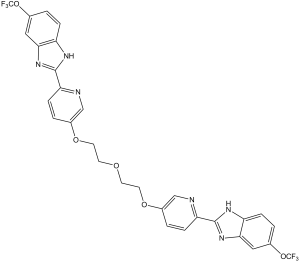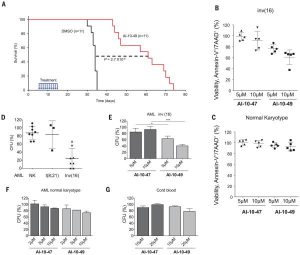This product is for research use only, not for human use. We do not sell to patients.

| Size | Price | Stock |
|---|---|---|
| 25mg | $270 | To Be Confirmed |
| 50mg | $470 | To Be Confirmed |
| 100mg | $720 | To Be Confirmed |
| 250mg | $1150 | To Be Confirmed |
| 500mg | $1850 | To Be Confirmed |
Cat #: V1895 CAS #: 1256094-72-0 Purity ≥ 98%
Description: AI-10-49 is a potent and selective inhibitor of the binding of CBFβ-SMMHC to RUNX1 with IC50 of 260 nM. AI-10-49 restores RUNX1 transcriptional activity, displays favorable pharmacokinetics, and delays leukemia progression in mice. Treatment of primary inv(16) AML patient with AI-10-49 triggers selective cell death. Direct inhibition of the oncogenic CBFβ-SMMHC fusion protein may be an effective therapeutic approach for inv(16) AML, and they provide support for transcription factor targeted therapy in other cancers. The stability of RUNX1, CBFb, and CBFb-SMMHC was not affected by AI-10-49.
Publications Citing InvivoChem Products
Product Promise

- Physicochemical and Storage Information
- Protocol
- Related Biological Data
- Stock Solution Preparation
- Quality Control Documentation
| Molecular Weight (MW) | 660.52 |
|---|---|
| Molecular Formula | C30H22F6N6O5 |
| CAS No. | 1256094-72-0 |
| Storage | -20℃ for 3 years in powder form |
| -80℃ for 2 years in solvent | |
| Solubility In Vitro | DMSO: 100 mg/mL (151.4 mM) |
| Water: 100 mg/mL (151.4 mM) | |
| Ethanol: <1 mg/mL | |
| Solubility In Vivo | 10%DMSO+90%PEG400: 30mg/mL |
| Synonyms | AI 1049; AI1049; AI-10-49; AI 10-49; AI10-49; AI-1049; |
| Protocol | In Vitro | In vitro activity: AI-10-49 displays specific growth inhibition of inv(16)-positive cell line ME-1. AI-10-49 selectively binds to CBFβ-SMMHC, disrupts its binding to RUNX1, and restores RUNX1 transcriptional activity. Kinase Assay: Cerulean-Runt domain is expressed and purified. Venus-CBFβ-SMMHC is constructed by inserting 6xHis tag and Venus into pET22b vector between NdeI and NcoI sites, and by inserting CBFβ-SMMHC (the CBFβ-SMMHC construct contains 369 amino acids, 1-166 from CBFβ and 166-369 from MYH11 (amino acids 1526-1730)) between the NcoI and BamHI sites. The fusion protein is purified by standard Ni-affinity chromatography with an on column benzonase treatment to remove residual DNA contaminants. Proteins are dialyzed into FRET buffer (25mM Tris-HCl, pH 7.5, 150mM KCl, 2mM MgCl2) prior to use. Protein concentrations are determined by UV absorbance of the Cerulean and Venus at 433 and 513 nm, respectively. Cerulean-Runt domain and Venus-CBFβ-SMMHC were mixed 1:1 to achieve a final concentration of 10 nM in 96 well black COSTAR plates. DMSO solutions of compounds are added to a final DMSO concentration of 5% (v/v) and the plates incubated at room temperature for one hour in the dark. A PHERAstar microplate reader is used to measure fluorescence (excitation at 433 nm and emission measured at 474 and 525 nm). For IC50 determinations, the ratios of the fluorescence intensities at 525 nm and 474 nm are plotted versus the log of compound concentration, and the resulting curve was fit to a sigmoidal curve using Origin7.0. Three independent measurements are performed and their average and deviation are used for IC50 data fitting. Cell Assay: Cell lines (HL-60, KG-1, THP-1, Kasumi-1, TUR 9, U937, and MOLM-13 cells) are cultured in IMDM supplemented with 10%~20% fetal bovine serum (FBS) according to culture conditions indicated by ATCC and 1% penicillin/streptomycin (Pen/Strep). All cell lines are tested for mycoplasma. Cells are cultured at 300,000 cells per ml in 96 well plates for 24 and 48 hours in DMSO, or different of AI-10-47, AI-410-49, AI-4-57, or AI-4-88); each in duplicate or triplicate. Cell viability is evaluated using DAPI by flow cytometry. Data is analyzed using FlowJo software and Graphpad Prism software. |
|---|---|---|
| In Vivo | In mice transplanted with Cbfb+/MYH11;Nras+/G12D leukemic cells, AI-10-49 (200 mg/kg, i.p.) reduces leukemia expansion. | |
| Animal model | Mice transplanted with Cbfb+/MYH11;Nras+/G12D leukemic cells |
| Solvent volume to be added | Mass (the weight of a compound) | |||
|---|---|---|---|---|
| Mother liquor concentration | 1mg | 5mg | 10mg | 20mg |
| 1mM | 1.5140 mL | 7.5698 mL | 15.1396 mL | 30.2792 mL |
| 5mM | 0.3028 mL | 1.5140 mL | 3.0279 mL | 6.0558 mL |
| 10mM | 0.1514 mL | 0.7570 mL | 1.5140 mL | 3.0279 mL |
| 20mM | 0.0757 mL | 0.3785 mL | 0.7570 mL | 1.5140 mL |
This equation is commonly abbreviated as: C1 V1 = C2 V2
- (1) Please be sure that the solution is clear before the addition of next solvent. Dissolution methods like vortex, ultrasound or warming and heat may be used to aid dissolving.
- (2) Be sure to add the solvent(s) in order.






































